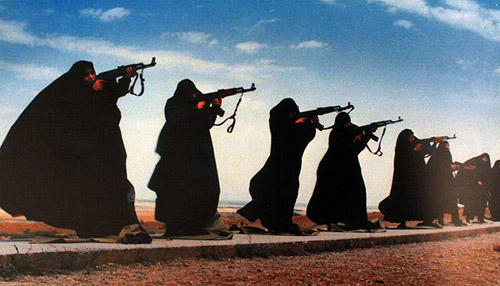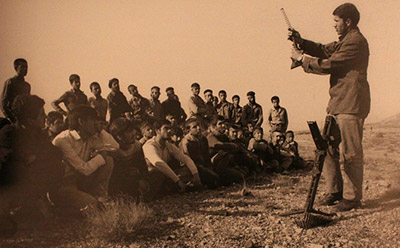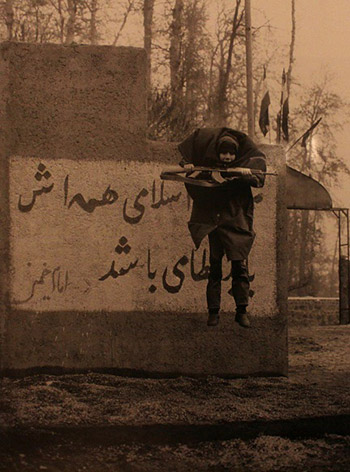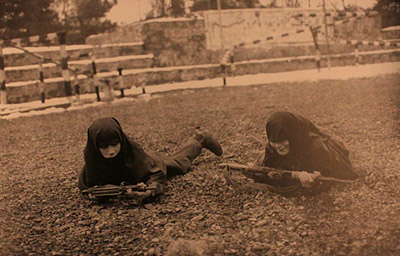Narrated by photos:
Military Training Course during Sacred Defense
Elham Saleh
Translated by: Fazel Shizard
2018-10-31
Amirali Javadian has started photography in Art Center since 1978. He went to the sacred defense's fronts in 1981 to photograph. At that time, he was the photographer- correspondent for News Agency of the Islamic Republic of Iran and continued until 1986. Javadian entered into the university after the years of imposed war by Saddam Hussein against the Islamic Republic of Iran, and received his doctoral degree from the collage of Fine Arts in 2004.
The photos chosen from the works of Amirali Javadian and will be shown below focus on military training during the sacred defense. At that time, the militant training of volunteers began from the mosques; they receive military training at the mosques and special places.

►Eight people; eight women. They want to shoot carefully. Here is rifle range, and women are being trained to shoot. Blue sky and white clouds show that it is a good weather for shooting. Each of them has a carpet piece underneath to kneel down, or even take some rest. They are ready to fight for Iran.
► Two persons; both of them have gun on shoulders. One who runs down a slope while both hands are full, and she is walking behind. Chitgar rifle range is the training place. They are wearing same uniform; grey or green mantle and both have tent, but they go down the slope quickly neglecting their clothes to be dirty in dust.

►All are young, but they are eager to defend the homeland. They must first receive training to be ready for fighting. They carefully look at what the trainer trains. These boys were only part of our groups who received military training by Bassij[1]

►Fighting is not just taking a weapon in hand; they should learn many things in Basij, such as crossing obstacles and heights. These three young people are also taking training course, while Iranian flag is fluttering in an airflow at the corner of the photo.

► A young girl who has come to receive military training to defend the country if needed. There is a sentence written on the wall behind him "The Islamic state must be military one." It is one of sentence of Imam Khomeini, dated Azar 1358 (December 1979).

► Ladies endure all the hardships of military training, just like these women (in the photo) who take guns in their hands and creeping. Both are staring at the ground as if they shrank from a look at the camera of the photographer, maybe they are still busy with training forgot his presence.

Source:
Permanent Frames 3: the Selection of sacred Defense's photos (photos by Amirali Javadian) / The Foundation for the Protection of Works and the Publishing of Sacred Defense Values
Number of Visits: 6950








The latest
- The 372nd Night of Memory – Part 3
- An Excerpt from the Memoirs of Mikail Ahmadzadeh
- Obstacles, Limitations, and New Horizons
- Third Regiment: Memoirs of an Iraqi Prisoner of War Doctor – 11
- 100 Questions/10
- The 23rd Commemoration Ceremony of the Martyrs of the Ansar al-Rasul Battalion Held
- A Narrative of Pakistani Pedestrian Pilgrims of Arbaeen in Sistan and Baluchestan
- Oral History Methodology/National Archives and Library Organization of Iran, Archives Research Institute
Most visited
- Oral History Methodology/National Archives and Library Organization of Iran, Archives Research Institute
- Third Regiment: Memoirs of an Iraqi Prisoner of War Doctor – 10
- The 23rd Commemoration Ceremony of the Martyrs of the Ansar al-Rasul Battalion Held
- 100 Questions/10
- A Narrative of Pakistani Pedestrian Pilgrims of Arbaeen in Sistan and Baluchestan
- Third Regiment: Memoirs of an Iraqi Prisoner of War Doctor – 11
- Obstacles, Limitations, and New Horizons
- The 372nd Night of Memory – Part 3
100 Questions/6
We asked several researchers and activists in the field of oral history to express their views on oral history questions. The names of each participant are listed at the beginning of their answers, and the text of all answers will be published on this portal by the end of the week. The goal of this project is to open new doors to an issue and promote scientific discussions in the field of oral history.The Importance of Pre-Publication Critique of Oral History Works
According to the Oral History website, a meeting for critique and review of the book “Oral History: Essence and Method” was held on Monday morning, November 10, 2025, with the attendance of the book’s author, Hamid Qazvini, and the critics Mohammad Qasemipour and Yahya Niazi, at the Ghasr-e Shirin Hall of the National Museum of the Islamic Revolution and Sacred Defense.Challenges of Interviewing in Oral History
After years of studying the theoretical foundations of oral history, conducting numerous interviews and going through their post-interview stages, as well as reading the available body of oral history literature, I was eventually given the opportunity to evaluate the edited versions of dozens of oral history projects.Comparing the Narratives of Commanders and Ordinary Combatants in the Sacred Defense
An Analysis of Functions and ConsequencesThe experience of the Sacred Defense cannot be comprehended merely through statistics or official reports; what truly endures from war are the narratives of those who stood upon its frontlines. These narratives, however, vary significantly depending on one’s position, responsibilities, and lived experience.


